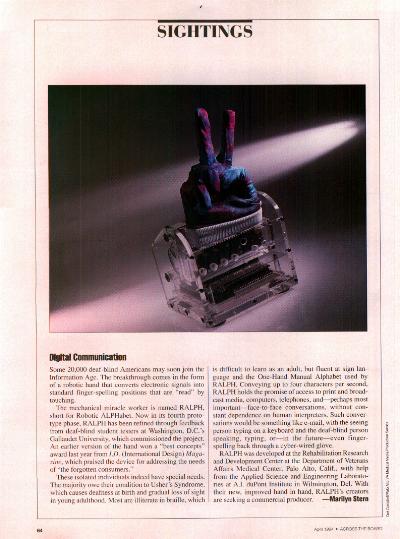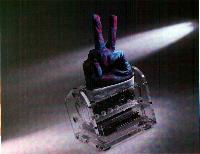
Across the Board Magazine
April, 1994

Sightings
April, 1994 - page 64
Digital Communication
by Marilyn Stern
 Some 20,000 deaf-blind
Americans may soon join the Information Age. The breakthrough comes in the form
of a robotic hand that converts electronic signals into standard
finger-spelling positions that are "read" by touching.
The mechanical miracle worker is named RALPH, short for
Robotic ALPHabet. Now in its fourth prototype phase. RALPH has been refined
through feedback from deaf-blind student testers at Washington, DC's Gallaudet
University, which commissioned the project. An earlier version of the hand won
a "best concepts" award last year from I.D. (International Design)
Magazine, which praised the device for addressing the needs of "the
forgotten consumers".
These isolated individuals indeed have special needs. The
majority owe their condition to Usher's Syndrome, which causes deafness at
birth and gradual loss of sight in young adulthood. Most are illiterate in
braille, which is difficult to learn as an adult, but fluent at sign language
and the One-Hand Manual Alphabet used by RALPH. Conveying up to four characters
per second, RALPH holds the promise of access to print and broadcast media,
computers, telephones, and - perhaps most important - face-to-face
conversations, without constant dependence on human interpreters. Such
conversations would be something like e-mail, with the seeing person typing on
a keyboard and the deaf-blind person speaking, typing, or - in the future -
even finger-spelling back through a cyber-wired glove.
RALPH was developed at the Rehabilitation Research and
Development Center at the Department of Veterans Affairs Medical Center, Palo
Alto, CA, with help from the Applied Science and Engineering Laboratories at
A.I. duPont Institute in Wilmington, DE. With their new, improved hand in hand,
RALPH's creators are seeking a commercial producer.
 |